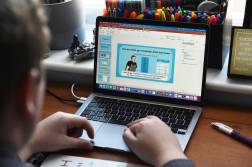When research on blended learning doesn’t match reality

When I first saw news reports warning to stop the expansion of virtual schools based on a new report from the National Education Policy Center, I wasn’t surprised.
As a former first-grade teacher, principal and parent of two students, I know technology will never replace the connection between teachers, families and students that is the foundation of academic performance. And my skepticism of virtual schools had been confirmed by more rigorous evaluations, such as the one released last year by Stanford’s Center for Research on Educational Outcomes.
But when I noticed that NEPC slipped “blended schools” into its annual virtual schools census this year – and that it leapt to some alarming conclusions – I was shocked. This finding flies in the face of the experiences of educators and administrators, in district and charter schools, who are purposefully integrating technology into classrooms nationwide to improve learning at scale.
So what is going on here? It seems part of the problem is how the NEPC altered the definition of blended learning to fit in their virtual schools report. The report uses a peculiar definition of blended schools as schools that combine “traditional instruction with virtual instruction,” and claims Rocketship Education as the category’s biggest operator.
As cofounder and CEO of Rocketship, I can say with certainty: We don’t use “virtual instruction” in any of our schools. We do use adaptive online learning programs to augment teacher-led instruction, but only within a classroom environment led by teachers, tutors and school leaders.
Although it is a bit troubling how NEPC manipulated the definition of blended learning for their virtual schools study, I am more concerned by the way they measured school performance. The report uses a statewide average of all grades as the benchmark, and then compares each individual school against that standard. So elementary schools, like Rocketship, are compared to a statewide average that includes elementary, middle, and high school students. What the NEPC does here is like comparing apples to applesauce.
What’s more, this study completely ignores the performance of important subgroups – such as students from low-income families, English Language Learners, and students with special needs. These are the students Rocketship is committed to serving – 88 percent of our students are classified as “socioeconomically disadvantaged.”
Rocketship’s mission to eliminate the achievement gap compels us to look specifically at socioeconomically disadvantaged students when we compare our student performance to local districts and the state. The report calls this “selective.” We call it transparent – and relevant. We don’t hide the performance of students from low-income families and we don’t think that the state, districts or researchers should, either.
I am proud of our progress at Rocketship. Our students outperform similar peers in nearby district schools and across the state in both English Language Arts and math (twice as many Rocketeers are proficient or advanced in math). Yet, I am the first to admit that we must do more to better serve our kids. Far too many students in disadvantaged communities are not on track to reach college.
By paying careful attention to individual student progress, and mapping those results back to the elements of schooling and instruction – and yes, even technology – that are driving student gains, we can better inform policymakers, educators, and parents about what it takes to boost student achievement and, ultimately, eliminate the achievement gap.
Preston Smith is Co-Founder & CEO of Rocketship Education, a non-profit network of public elementary charter schools serving low-income communities in California, Wisconsin, Tennessee, and Washington, D.C.




